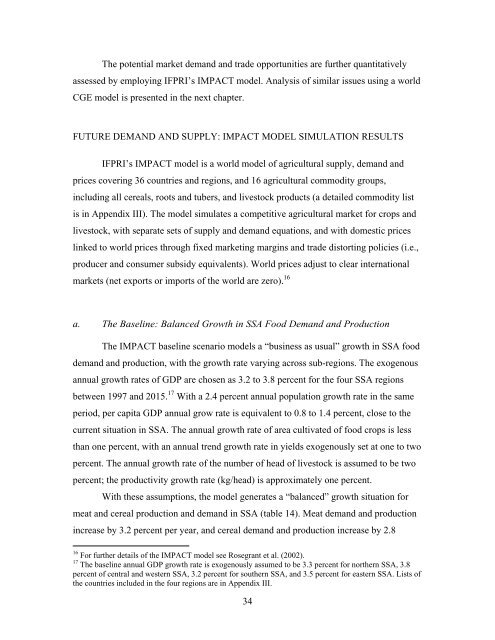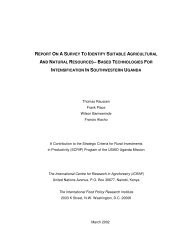Market Opportunities for African Agriculture - International Food ...
Market Opportunities for African Agriculture - International Food ...
Market Opportunities for African Agriculture - International Food ...
Create successful ePaper yourself
Turn your PDF publications into a flip-book with our unique Google optimized e-Paper software.
The potential market demand and trade opportunities are further quantitatively<br />
assessed by employing IFPRI’s IMPACT model. Analysis of similar issues using a world<br />
CGE model is presented in the next chapter.<br />
FUTURE DEMAND AND SUPPLY: IMPACT MODEL SIMULATION RESULTS<br />
IFPRI’s IMPACT model is a world model of agricultural supply, demand and<br />
prices covering 36 countries and regions, and 16 agricultural commodity groups,<br />
including all cereals, roots and tubers, and livestock products (a detailed commodity list<br />
is in Appendix III). The model simulates a competitive agricultural market <strong>for</strong> crops and<br />
livestock, with separate sets of supply and demand equations, and with domestic prices<br />
linked to world prices through fixed marketing margins and trade distorting policies (i.e.,<br />
producer and consumer subsidy equivalents). World prices adjust to clear international<br />
markets (net exports or imports of the world are zero). 16<br />
a. The Baseline: Balanced Growth in SSA <strong>Food</strong> Demand and Production<br />
The IMPACT baseline scenario models a “business as usual” growth in SSA food<br />
demand and production, with the growth rate varying across sub-regions. The exogenous<br />
annual growth rates of GDP are chosen as 3.2 to 3.8 percent <strong>for</strong> the four SSA regions<br />
between 1997 and 2015. 17 With a 2.4 percent annual population growth rate in the same<br />
period, per capita GDP annual grow rate is equivalent to 0.8 to 1.4 percent, close to the<br />
current situation in SSA. The annual growth rate of area cultivated of food crops is less<br />
than one percent, with an annual trend growth rate in yields exogenously set at one to two<br />
percent. The annual growth rate of the number of head of livestock is assumed to be two<br />
percent; the productivity growth rate (kg/head) is approximately one percent.<br />
With these assumptions, the model generates a “balanced” growth situation <strong>for</strong><br />
meat and cereal production and demand in SSA (table 14). Meat demand and production<br />
increase by 3.2 percent per year, and cereal demand and production increase by 2.8<br />
16 For further details of the IMPACT model see Rosegrant et al. (2002).<br />
17 The baseline annual GDP growth rate is exogenously assumed to be 3.3 percent <strong>for</strong> northern SSA, 3.8<br />
percent of central and western SSA, 3.2 percent <strong>for</strong> southern SSA, and 3.5 percent <strong>for</strong> eastern SSA. Lists of<br />
the countries included in the four regions are in Appendix III.<br />
34
















